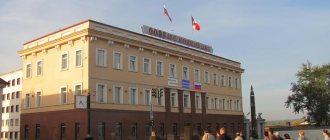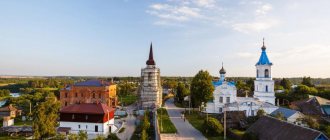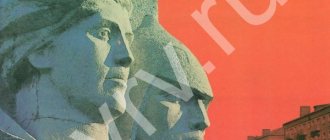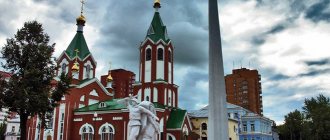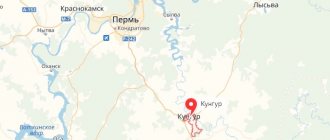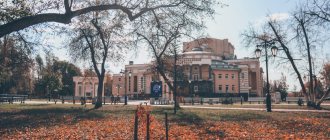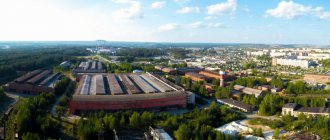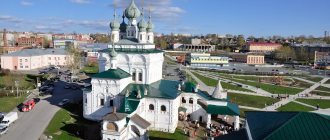Tchaikovsky Estate Museum
It is an object attractive for visiting by admirers of the great composer’s music from all over the world. Every year in the museum you can attend a music festival dedicated to the composer. In this house, located on the shore of the Votkinsk pond, Pyotr Ilyich Tchaikovsky was born and spent his childhood there. The charm of the surrounding landscapes caused the impressionable boy to express his feelings in music.
The atmosphere of those times has been preserved in the house where the Tchaikovsky family lived. Visitors view the exhibits, the main one of which is the piano , which the little Pyotr Tchaikovsky himself played. During the excursions, the composer's music is performed. The view from the window is a picturesque pond. It is believed that it was he who inspired the future composer to compose music for the ballet “Swan Lake”. A walk through the adjacent garden with centuries-old linden trees will help you feel the atmosphere of that time.
Address: Tchaikovsky street-119.
What to see in Votkinsk
Votkinsk is the oldest city in its region - it was founded back in 1759. The legacy of the three centuries through which it passed was a rich history, unique old Russian architecture and interesting customs that cannot be found in other parts of our country. Once in Votkinsk, the first thing you should do is pay attention to its main attractions, which are of great importance for the history and culture of the city, and are also its pride.
Museum-Estate of P.I. Tchaikovsky
- Address: st. Tchaikovsky, 119.
The greatest composer Pyotr Ilyich Tchaikovsky was born in the village of Votkinsk in 1840. His native estate was empty when the family left Votkinsk. For a long time the house remained abandoned, and in the 1930s. and was completely in disrepair.
In 1940, in honor of the centenary of the birth of the outstanding musician, it was decided to restore the family estate and organize a memorial museum in it. After restoration, the stone manor acquired its original appearance: the architects managed to revive the smallest details. This is exactly what this house was like on the night when Pyotr Tchaikovsky was born.
The museum is dedicated to the life of the Tchaikovsky family and the creative development of the composer. The halls recreate the homely atmosphere in which Peter spent his childhood. The rooms are furnished with original 19th century furniture. On the tables, fireplaces and shelves you can see antique things that belonged to the musician - books, watches, candlesticks, dishes, stationery. Children's toys that little Petya Tchaikovsky played with are placed on the floor.
The Tchaikovsky estate is a special asset of Votkinsk. It is one of the city's most visited museums and appeared on the reverse of a three-ruble coin issued to celebrate the 450th anniversary of Udmurtia's entry into Russia.
Museum of History and Culture of Votkinsk
- Address: st. Kirova, 5.
The Votkinsk Museum of Local Lore was opened in February 1968. The initiative to create it belonged to local historians V.N. Stupishin and F.V. Streltsov. The exposition of the attraction is located in a two-story building.
The first floor is occupied by an exhibition called “Factory City”. She talks about how people of different classes lived in Votkinsk at different times: merchants, nobles, peasants and workers. Illustrations for this story are household items of the 19th-20th centuries: furniture, musical instruments, samples of costumes, paintings, devices for processing fabric, cultivating land, and so on.
The exhibition “Lada” is located on the second floor. It is an art gallery that presents the works of landscape painters who captured the natural beauty of Udmurtia on canvas.
In addition to exhibition activities, the museum takes an active part in the cultural life of the city, organizing creative competitions, musical evenings, folk festivals, meetings with writers and artists.
Blagoveshchensky cathedral
- Address: st. Kirova, 1.
The Annunciation Cathedral was erected in the first half of the 18th century on the site of an ancient church burned by the Pugachevites.
The white stone temple was rebuilt several times, but always retained its majestic appearance. It is decorated with snow-white semi-columns with figured capitals, porticoes, and frequent lancet windows. The round drum is topped with a massive golden dome. The building is adjacent to a tiered bell tower with a high gilded spire. The cathedral became famous due to the fact that it was here that Pyotr Tchaikovsky was baptized.
The dark period for the shrine began in December 1918, when the Bolsheviks executed priest Nikolai Chernyshev and his daughter Varenka. After this, the temple was closed. In the 1930s, a campaign was organized to destroy the architectural appearance of the church. Wall frescoes with biblical scenes were damaged, jewelry and church utensils were robbed and recycled, icons were used to light stoves, domes and bells were discarded and melted down.
Until the 21st century, the House of Culture named after Lenin operated in the temple building. In the winter of 2001, restoration work began, returning the cathedral to its former appearance. In August of the same year, the first liturgy was served and the temple again began to receive parishioners.
Today the Annunciation Cathedral is a historical and architectural monument, and is also considered a symbol of Votkinsk.
Monument to Tchaikovsky
Next to the estate museum there is a monument to Tchaikovsky. The majestic monument is made in the form of a composer sitting on a bench. The bench is located on a pedestal on which the inscription “P.I. Tchaikovsky."
The graceful pose and pensive face of the composer suggest that he is captured at the moment when great music is born in his soul, which will give many happy moments to its connoisseurs.
Address: Tchaikovsky street-119.
Votkinsk: attractions. Photos and list of tourist sites of the city
“The Nutcracker”, “Ondine”, “Swan Lake” - it is difficult to find a person who has not heard of these immortal musical works. And the name of the author of these works is probably familiar to everyone. But Votkinsk is Pyotr Tchaikovsky’s small homeland.
The city's attractions are not at all limited to objects associated with the life and work of the outstanding composer. There is still a lot of interesting and remarkable things here!
So, let's try to list the main attractions of the city of Votkinsk. Here they are:
- House-Museum named after P. I. Tchaikovsky.
- City embankment and dam of the Votkinsk “sea”.
- People's Museum of Local Lore of the city.
- Annunciation Cathedral of the early 19th century.
- Panteleimon Church (late 19th century).
- Old (Nikolaevsky) building of the Votkinsk plant.
- Monument to the poet and musician Vladimir Vysotsky (opened in 2016).
The pre-revolutionary low-rise buildings of Votkinsk are worthy of attention and study. Dozens of cute brick and wooden houses will definitely not leave admirers of traditional Russian architecture indifferent. In addition, most of the city's historical buildings are in decent and quite presentable condition.
It will be difficult to describe in detail all the sights of Votkinsk in this article. But we will definitely get to know the most interesting of them further.
Blagoveshchensky cathedral
The main square of the city is decorated with the Annunciation Cathedral, where Pyotr Tchaikovsky was baptized at birth. The pointed tower crowning it is visible from afar. The cathedral is a cultural monument of Russian classicism.
The history of the cathedral is a history of destruction and restoration. Despite the fact that it is now being restored, the Annunciation Cathedral in this state still represents a unique monument.
Address: Kirova street-1.
Votkinsk architecture
In Votkinsk, modern buildings coexist with houses that remember the formation of the city. Tchaikovsky himself probably walked past these ancient buildings.
Terem Ovchinnikova
- Address: Republican street, 104.
The two-story estate, located on Republican Street, has adorned the city since the end of the 18th century. Its owner was the forester Alexey Ovchinnikov. He designed the house himself and took part in its construction. The wooden tower looks like it came straight from the pages of a fairy tale.
Despite the fact that its colors have faded, one can still discern elegance and fantasy in it. The tower is distinguished by sharp turrets on the sides, lace cornices, and assorted windows with carved frames.
After the Ovchinnikov family moved, the Zarechnaya Library was located in the house, and later employees of the Votkinsk plant began to be housed in it. During the Soviet Union, a kindergarten was opened in the tower, which existed until the 1990s. Today the Ovchinnikovs' house is empty, awaiting restoration.
"Red" hospital
- Address: 1 May Street, 132.
The impressive red brick building was erected at the turn of the 19th and 20th centuries. at the expense of the merchants Sozykin and Kalashnikov. The spacious three-story structure with two-story outbuildings on either side served as an almshouse for many years and functioned as an army hospital during World War II. Despite its venerable age, the building is in excellent condition and pleases the eye with its beauty. Today there is a city clinic here.
Church of St. George the Victorious
Despite the fact that the church was built today, it is one of the attractions of Votkinsk. A competitive selection of architectural designs took place, as a result of which the Cathedral of Christ the Savior was chosen in the form of a smaller copy. The dome of the temple is crowned with a cross weighing 160 kilograms . The highest place in the city was allocated for construction.
Address: Lunacharskogo street-35.
History paragraph
An ancient settlement was located on the site of the modern city for quite a long time. The first mentions of it date back to the 3rd-5th centuries and are associated with the Mazunin archaeological culture. In 1757, during the construction of the Votkinsk ironworks, a village was founded. But, despite this, the official date of the appearance of the village is considered to be 1759.
Composer Tchaikovsky was born here and lived until he was eight years old. He wrote some of his works under the impression of Votkinsk. In particular, the prototype of “Swan Lake” was the Votkinsk pond.
Votkinsk Dam
The one kilometer long area adjacent to the Votkinsk Pond is called the Votkinsk Dam. It was built as a structure necessary for an ironworks. Now these buildings have lost their significance and are not functioning, but the dam continues to be a landmark of the city.
The remaining structures are historical exhibits. The picturesque view offered from the dam attracts city residents and its guests.
Address: Mira Street.
Where to go for a walk in Votkinsk with children and adults
Fresh air, clean waters, green streets and amusement parks - all this is about Votkinsk. There are a huge number of options for where and how to spend time in nature.
Island Beach
- Address: Berezovka microdistrict.
“Island” is a sandy beach on the shore of Votkinsk pond. The territory is beautifully landscaped and stylized as a hotel recreation area. Everything you need is here:
- sun loungers,
- changing cabins,
- umbrellas,
- rental of watercraft (catamarans, jet skis),
- bridges for entering the water.
There are also cozy cafes and areas for ball games. The beach is kept in perfect order: sand and water are regularly cleaned. Passage with animals and food is strictly prohibited, as is smoking in non-designated areas. There is a fee to visit the “Island”, but the entrance fee is low.
Votkinsk Dam
- Coordinates on the map: 57.052104, 53.981250.
The Votkinsk dam stretches for a whole kilometer. Along its territory there are various industrial buildings that functioned during the era of prosperity of the ironworks, and now play an exclusively expositional role.
Not long ago, the dam was landscaped for walking: paved paths, decorative lanterns and comfortable benches appeared, while relaxing on which you can admire the beautiful view of the Votkinsk pond and the panorama of the far shore.
Amusement park "Fiesta"
- Address: Mira Street.
Fiesta Park is located near the Votkinsk embankment, in the thick of a birch grove. As reviews online say, this is an ideal place to relax with children of different ages. Young visitors are offered a large selection of carousels, swings, and trampolines. The “Funny Little Engine”, “Chains” and the classic carousel with horses are very popular attractions.
In addition to the attractions, the park has many shops selling sweets, drinks and souvenirs. “Fiesta” works not only in summer, but also in winter. During the frosty season, a skating rink is filled here and an ice town is built. The park serves as a venue for entertainment events, concerts, and on holidays games, competitions and costume shows are held here.
Monument "Anchor"
In order to appreciate the significance of this monument, one must understand what contribution the Votkinsk plant made to the development of industry throughout the country.
The plant mastered a new method for producing tool steel, thanks to which high-quality metal-cutting tools were produced. When the specialization changed to metallurgical, the production of steamships and steam locomotives began. During the war, the production of anti-tank guns was mastered, and in the post-war years - ballistic missiles.
In the 19th century, it produced more than half of all anchors manufactured at numerous Ural factories. The quality of the anchors was so high that it made it possible to equip the largest of the battleships with them.
The anchor weighing 167 pounds was made in 1837. On the monumental monument there was a carved inscription that the heir to the throne (future Alexander II) took part in the forging. On the other side of the anchor there is an inscription that the production was carried out at the time when Lieutenant Colonel Tchaikovsky was the mining commander.
The original version of the monument was melted down, but was restored for the celebration of the bicentenary of the Votkinsk plant in 1959. As a result of a competitive selection, the Anchor monument was recognized as one of the symbols of Russia.
Address: Azin and Tchaikovsky Street.
The monument to the leader of the world proletariat looks quite curious in Votkinsk.
Curiosities with the Lenin monument are not uncommon. In Chelyabinsk, like in any other Russian city, on the main square there is the ghost of communism - a monument to the leader of the world proletariat. Sergei Dovlatov wrote about the curiosity associated with the installation of the monument in one of his stories. When, at the opening of the monument on November 7, 1959, officials pulled off the veil, everyone present in the square saw Ilyich in the usual pose of a voting tourist. With one hand he pointed the way to the future, and in the other he clutched his cap. At the same time, there was another cap on his head.
The whole square laughed except for one unfortunate Leningrad sculptor. The fact is that all the statues were then cast in Leningrad, but not entirely, but in parts, and then the pieces were welded. The sculptor himself talks about this: “There was a workshop where monuments were mass-produced for different squares, recreation centers, village councils... That is, there were a bunch of blanks: heads, torsos, legs... And Lenins were assembled like a construction set. Well, they blinded this Ilyich due to drunkenness.”
A very funny inscription on the Lenin monument in Miass (Chelyabinsk region)
Lenin in Miass Who is a whipper? Probably few people know. This is the worker who cuts the notches on the files. It turns out that in 1923, at a meeting of factory workers, it was proposed to enroll V.I. Lenin. into the staff of the plant workers for the position of a cutter, probably to give the sawmill some significance. A telegram was sent to Comrade Lenin about this and he was given a workplace for the right to work in which socialist competition was taking place. The monument was erected in 1924. Moreover, Ilyich was still on the plant’s staff until 1991.
Now there is a debate in society about the demolition of numerous stamped figures, which are often in a very deplorable or even disrepair state, just like ideology. For example, in Satka it completely collapsed. But the insect keeper must be left behind! There is a proposal to concentrate all the monuments of the communist era somewhere in one place, this has already been done in Moscow. Chelyabinsky Ilyich on Revolution Square is periodically washed before his birthday (April 22) and sometimes restored, which costs a lot of money. In addition, this is the vertical on which the architectural composition of the square rests. In short, if you remove the monument to Lenin, then you need to put up something else. So it turns out: you can’t leave it behind. When the monument was being installed in Chelyabinsk, the regional leaders complained that they had to stand for several hours in the cold, and there were no amenities nearby, and then under the pedestal they made a secret heated room with a toilet, a buffet and a guard to guard it. Secretaries ran there to warm themselves with KVK, the highest quality cognac. And in the 70s, the electrical wiring shorted out and the whole room burned out from the inside. This happened at night. It is interesting that already in the morning the Voice of America reported that a monument to Lenin burned down in the city of Chelyabinsk. Later the room was concreted and the pedestal was lined with new slabs.
Lenin in Ozersk
In the city of Ozersk, Chelyabinsk region, at the entrance to the park, a plaster statue of Lenin collapsed so badly that it began to threaten the lives and health of people. The monument stood there for 60 years, it was repaired many times, but time inexorably took over. For a whole year, starting in May 2012, there were discussions: to dismantle or restore or replace with a new one. Finally they decided that the new Ilyich would cost the treasury too much, further resuscitation was not possible, demolition remained. Which is what was done.
Now the monument looks like this.
A discussion took place in the city on the topic “What to put instead?” 1. Leave it like this. For Ilyich’s fans it will be “Those Legs.” And for everyone else - the sculptural composition “Those on the Road.” 2. Bring back Lenin! 3. Christmas tree! 4. Fountain or flower bed. 5. Bust Semenovich. 6. Tank! 7. Girl with a paddle! A different era has arrived and a whole generation of people has grown up unfamiliar with the idols and symbols of the Soviet era. In the same park there is also a sculpture of Volodya Ulyanov as a child, very similar to the image on our October badge. We conducted a survey among school-age children: “Who is this?” Most of the children answered “I don’t know”; one version was “little Pushkin”. As you know, in Soviet times, monuments to Lenin should have stood everywhere. One day a funny thing happened on a collective farm. There was no time to erect the statue for the next anniversary of Soviet power. And the hacks cut it out of foam plastic and painted it with bronze paint. At the grand opening, Lenin was blown away by the wind and the entire collective farm ran after him across the field until they caught him.
Lenin on cheese
In some cities, especially small ones (like Ozersk or Satka), the local budget does not have enough money to maintain the monument, and Ilyich naturally deteriorates, collapses and dies quietly, especially if it is made of plaster. In some cities (like Voronezh) they try to sell it to someone as non-ferrous metal if the monument is cast in bronze. Sometimes irresponsible citizens express their creativity on the monument. For example, in the city of Nakhodka they painted a pedestal so that Lenin sits as if on a piece of cheese.
perevalnext.ru
Monument to the 8K-14 ballistic missile
The monument in the form of a rocket is located near the entrance of the Votkinsk plant. Evidence of the production of missiles of this kind at the plant. The length of the rocket is more than 15 meters . It is installed on a pedestal, where the technical data is indicated on the attached plate. The missile is a closed object, so you are not allowed to get close to it.
Address: Kirvoa street-2.
Museum of History and Culture of Votkinsk
The museum building consists of two floors.
- On the ground floor there is an exhibition “City-factory”, dedicated to the life of city residents. The exhibition tells about the history of the city, its traditions, and highlights the life of workers, merchants, and intelligentsia.
- On the second floor there is another exhibition called “Lad”. It introduces you to the unique nature of the region, which is reflected in the paintings of local artists.
- In addition to permanent exhibitions, the exhibition hall also hosts traveling exhibitions.
- The museum also hosts musical evenings, folk festivals, and meetings with famous people.
Address: Kirova street-5.
Nikolaevsky building of the Votkinsk plant
The housing is located inside the plant. It is a very high tower, so you can see it from outside the factory area. The Nikolaevsky building is one of the ancient projects, reminiscent of the development of the city and its importance in industry.
Address: Kirova street-2.
Church of the Transfiguration
In addition to its historical and spiritual value, the temple is an interesting work of architecture. Its originality lies in the fact that it is the only cathedral built in the Russian-Byzantine style. The building is beautiful not only outside, but also inside, where there is a huge iconostasis and painted vaults.
Address: Pioneer Street-1.
Religious buildings of Votkinsk
Orthodox churches in Votkinsk belong to different centuries and architectural styles. Each of them has its own history, firmly intertwined with the history of the city.
Church of the Transfiguration
- Address: st. Pionerov, 3.
The red-brick temple was built in the 19th century on the site where its predecessor wooden church stood, burned by the Pugachevites. The new temple complex was built in the Russian-Byzantine style.
A two-tier bell tower with a hipped roof, pyramidal turrets, a massive silver dome and stained glass glazing gives it a special charm. The interior decoration has been preserved from the century before last: the impressive iconostasis and paintings on the vaults are remembered by several generations of parishioners.
The Transfiguration Church was one of the few religious institutions that continued liturgical activities during the Soviet years. Thanks to this, the church avoided vandalism and remained intact.
Church of St. George the Victorious
- Address: st. March 8, 142.
The young temple stands on the highest point of the city of Votkinsk - its golden dome is visible from afar. The church was built in the early 2000s, but in appearance it resembles the cathedrals of Tsarist Rus'. The white stone building in the Russian-Byzantine style is made without frills, but with grace, which is given to it by massive arches and faceted columns. The parish area is very well-groomed and equipped for families with children.
Panteleimon Church
- Address: st. Krylova, 3.
The Panteleimon Temple was built at the end of the 19th century. This is a brick building in pseudo-Russian style. The architectural composition is complemented by side porches and a two-tier hipped bell tower. The whitewashed facades are decorated with ornaments of figured masonry and acanthus.
The church received parishioners until March 1929. After its closure, its premises were used at various times as a cinema, a mechanical workshop, a small goods base and a woodworking plant. Many temple extensions were demolished, and in their place garages, warehouses and workshops appeared.
The city council made the decision to return the building to the Izhevsk diocese in 1991. Over the next five years, large-scale restoration work took place in the temple, during which the bell tower was reconstructed, industrial buildings were demolished, and the internal layout of the liturgical halls was restored.
Panteleimon Church resumed its activities in 1996. Since then, parishioners have visited her every day.
Nagornoye Cemetery
Pre-revolutionary burials of the first settlers of Votkinsk have been preserved. On it you can see the graves of famous people of the city, as well as soldiers who died during the war, because dozens of hospitals were located there. The cemetery is located in the city center, so there are always a lot of visitors there.
Address: Verkhnyaya street - 1.
